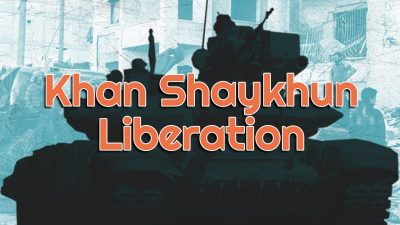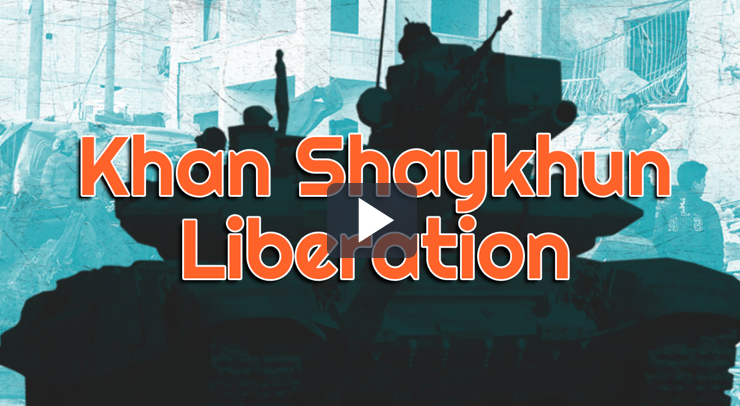Video: “Dawn of Idlib”: Syrian Army’s Offensive in Northwestern Syria

August 2019 was marked by important changes on frontlines in northwestern Syria.
The month started with a declaration by Hayat Tahrir al-Sham leader Abu Mohammad al-Julani that his group, the most powerful faction in Idlib and formerly the official branch of al-Qaeda in the country, rejects the Idlib demilitarization zone agreement and would not withdraw a single fighter or weapon from the area “upon the wishes of the enemies or the friends”. Al-Julani declared that it’s the duty of the terrorist group to defend what he called “liberated areas”.
The withdrawal of radical militants [terrorists] and heavy equipment from the 20km-deep demilitarized zone agreed to in the Astana talk’s framework was the key demand of the September 2018 agreement aimed at de-escalating the situation at the contact line between the Syrian Arab Army (SAA) and the so-called opposition in northwestern Syria. Nonetheless, this agreement has never been honored by Hayat Tahrir al-Sham, other al-Qaeda-linked groups, or even Turkish-backed formations. They saw the agreement, as well as the establishment of Turkish military posts observing the supposed ceasefire, as a kind of diplomatic shield -allowing them to attack the SAA and forbidding the SAA to respond. This turned the demilitarization agreement into a source of constant tensions and competing accusations.
Furthermore, Hayat Tahrir al-Sham used the gained lull in the battle with the SAA to consolidate its control of the Greater Idlib area. According to Russian President Vladimir Putin, before the establishment of the Idlib demilitarized zone, terrorists had controlled 50% of its territory whereas, up until recently, 90% of Idlib’s territory was controlled by terrorists.
Watch the video here.
There were three ways to deal with this situation:
- First, and the most preferred by militants and their foreign supporters, the SAA stops responding to ceasefire violations and continues to silently take casualties;
- Second, implementation of the Idlib agreement whereby Radical militants and heavy weapons are withdraw from the demilitarized zone and the ceasefire regime obeyed, thus making an important step en route to de-escalattion of the situation in northwestern Syria;
- Third, the SAA resumes operations against radical militants, eliminates the threat, and imposes demilitarization by force.
These choices predetermined further developments in the area. In the period from April to July, the SAA and its allies made a series of limited advances in northwestern Hama and southern Idlib liberating Kafr Nabudah and several nearby villages. During the same period, the Damascus government, backed by Russia and Iran, proposed several ceasefires giving militants and their backers multiple chances to begin fulfilling the terms and conditions of the agreement. However, Hayat Tahrir al-Sham and other militant groups apparently interpreted these proposals as signs of weakness. They were wrong.
On August 7, government forces resumed offensive operations liberating the villages of Al-Zakah and Arbain in northern Hama. On August 8, the SAA liberated al-Sakhr, al-Jaysat and Tell Sakhar. Control of the important height of Tell Sakhar allowed government forces to increase pressure on militants in the town of Hobit and secure Hamamiat. By August 11, the SAA had liberated Hobit, as well as Sukayk, Tall Sukayk, and Mughar Al-Hamam.
Despite multiple reinforcements deployed by Turkish-backed groups from the coalition known as the National Front of Liberation, the militants’ defense started collapsing. By August 19, the SAA, the Tiger Forces, and the National Defense Forces had outflanked the militant stronghold of Khan Shaykhun from the northwestern direction by liberating Tal Nar and nearby villages. Militants even employed MANPADs to fend off the SAA offensive. On August 15, they downed a Syrian Air Force Su-22 warplane over southern Idlib, but this was not enough.
In the period from August 15 to August 18, the SAA repelled several militant counter-attacks, involving suicide bombers, in the areas of Sukayk and Tal Nar, and reached the entrance of Khan Shaykhun.
On August 19, Turkey made a last fierce attempt to rescue militants in northern Hama. Ankara sent a large military convoy of at least 28 pieces of military equipment, including 7 battle tanks, towards Khan Shaykhun. Members of Turkish-backed militant groups accompanied the convoy. The plan was to establish an observation point near Khan Shaykhun and use Turkish troops as human shields to defend militants there. However, the convoy was prevented from reaching the target.
The SAA cut off the highway leading to Khan Shaykhun while the Syrian Air Force carried out several strikes along the path of the Turkish convoy near Heish -killing at least one militant field commander and destroying a machine gun-armed vehicle.
On August 21, government forces liberated Khan Shaykhun and fully encircled the positions of militants in northern Hama. On August 23, the SAA and its allies fully liberated the newly created pocket including al-Lataminah, Morek, and Kafr Zita. By that time, most of the militants had already fled the area towards their positions north of Khan Shaykhun. The Syrian military fully liberated northern Hama.
Both sides provide highly overestimated numbers of their enemies’ casualties. For example, pro-militant sources claim that over 1,200 government troops were killed in the area. This number is not confirmed by any visual evidence. In their own turn, pro-SAA sources claim that over 1,000 militants were eliminated. This is also not realistic. However, photos and videos from the area show that about 2 dozens pieces of the militants’ military equipment were destroyed.
Khan Shaykhun became widely known around the globe in 2017 after the US leadership used the staged chemical provocation in the militant-held town to carry out a massive missile strike on the Syrian Air Force’s Shayrat Air Base.
Since then, the town had been a visible symbol of success of Western-backed propaganda organizations, first and foremost the White Helmets, operating in Syria and working to promote the regime-change agenda. Therefore, its liberation became an important symbolic victory of the Syrian-Iranian-Russian alliance.
From the military point of view, the SAA secured an important chunk of the M5 highway and expanded a buffer zone at the Hama-Idlib administrative border. Previously, militants actively used their positions in northern Hama to shell government-controlled areas. Mhrdah, Suqylibiyah, Qamhanah, and Salhab were among the most frequent targets of shelling by militants, leading to dozens of civilian casualties during the last few months alone.
Besides these Hayat Tahrir al-Sham lost a large part of its defense infrastructure in the southern part of the Idlib zone. Khan Shaykhun, located directly on the M5 highway, was an important logistical hub allowing radical militant groups to re-supply their fighters at the frontline, while al-Lataminah, Murak, and Kafr Zita were important strong points. Full of underground tunnels and weapons depots, these towns were the core fortifications of militants in the area. The command center of Jaysh al-Izza, the main Hayat Tahrir al-Sham ally in northern Hama, was also located there. The group, having now lost all of its areas, has turned into a kind of nomad tribe within the militant-held part of the Idlib zone.
The estimated pre-war population of the areas recently liberated by the SAA was around 140,000 people. Even taking into account displacements during the war, Idlib radicals lost a notable part of their potential forceful mobilization potential and targets for various informal fees imposed by militant groups across northwestern Syria.
In its own turn, the SAA and its allies demonstrated that they are capable of delivering a military blow to militants entrenched in Idlib and that the key reason of their patience in previous months was the multiple attempts to settle the conflict and de-escalate the situation through diplomatic means. The key factor opposing this scenario remains the same: the inability of the so-called moderate opposition, backed by Turkey, to separate from terrorists. These groups are too deeply integrated. If nothing changes in this regard, another round of hostilities in the Idlib zone is almost inevitable.
*
Note to readers: please click the share buttons above or below. Forward this article to your email lists. Crosspost on your blog site, internet forums. etc.
We call upon Global Research readers to support South Front in its endeavors.
If you’re able, and if you like our content and approach, please support the project. Our work wouldn’t be possible without your help: PayPal: [email protected] or via: http://southfront.org/donate/ or via: https://www.patreon.com/southfront


